Carp are extraordinary fish and each and every one of them is a uniquely special catch. As there are so many species and subspecies of carp, each having an individual set of features, it can be rather easy to get confused about the different types of carp.
That’s why I wrote this in-depth species guide.
The carp family (Cyprinidae) has many members and relatives. The most common types of carp include the common and mirror carp, as well as their closely related variants leather, linear, and ghost carp. Grass, koi, crucian, and silver carp are not directly related to the common carp.
Read all about the different carp types and their respective features and sizes in this complete species guide.
Common Carp
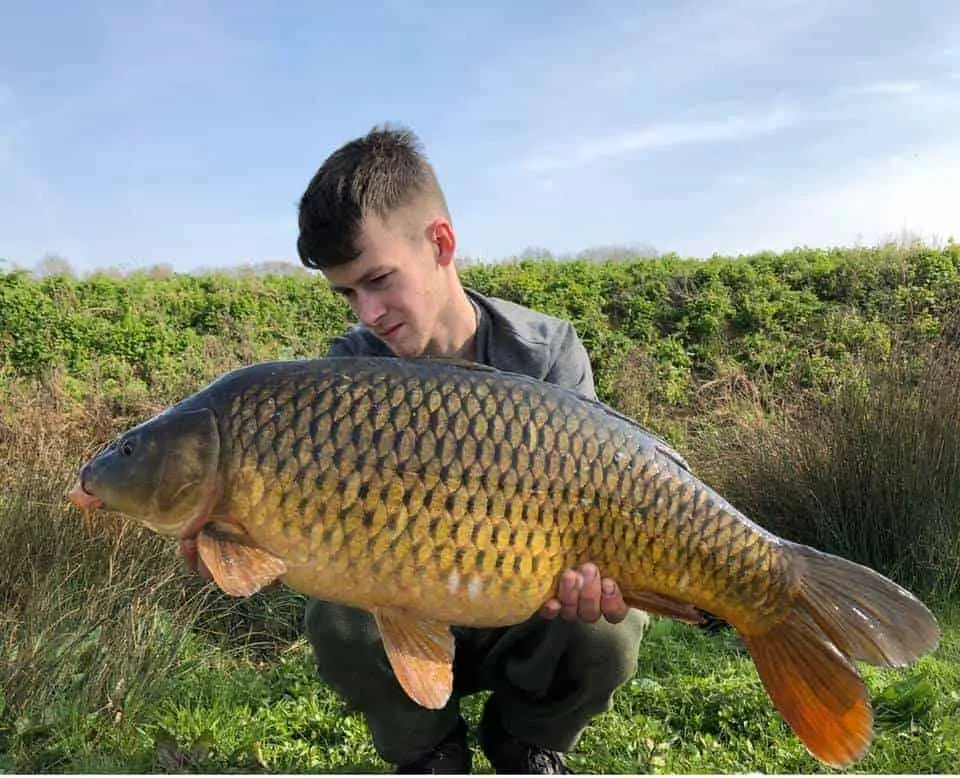
History
The common is the original carp prototype that made its way from Asia to all the corners of the world. After being domesticated for centuries in Asia, it was introduced to European waters in the 12th century.
In the 16th century, the first carp were introduced in British ponds and lakes, and roughly 200 years later, the first common carp were brought to North America.
Features and Appearance
Common carp are fully covered by beautiful, replicated patterns of scales. It sort of looks like they are wearing body armor. They do not possess the same individually unique features that other carp types have, but are often very popular among anglers nonetheless.
Sometimes, due to the mere fact that many venues are stocked with more mirror carp than common carp.
They are most commonly bronze or brown in color and have a reddish, or sometimes even orange tail fin.
Their body shape is often slim and torpedo-like, as they once were native to rivers and fast-flowing water, but there are common carp who have a much deeper and rounder body.
As common carp have held on to their wild and untamed nature, they are quite strong and tough fighters on the rod and won’t give up easily. This is another reason why the common carp, especially the bigger-sized ones, are such a popular target fish.
Average Size
A common carp of between 15 to 25lb is considered an average-sized fish in most countries. Fish under 10lb are rather small for being common carp.
Fish above 25lb are considered a good-sized common carp, while commons of 30lb and above can be called big, specimen-sized carp.
Record Catches
The British record is a carp of 64lb 6oz, which was caught in The Avenue (RH Fisheries) in 2018.
The official U.S. common carp record is a fish of 54lb 8oz that was caught in a river system in New Jersey.
The world record common carp is a gigantic fish of 101 lbs 6 oz. It was caught in the French carp venue Lake Serene in 2019.
RELATED ARTICLE: Find out about all the differences between common and mirror carp!
Mirror Carp
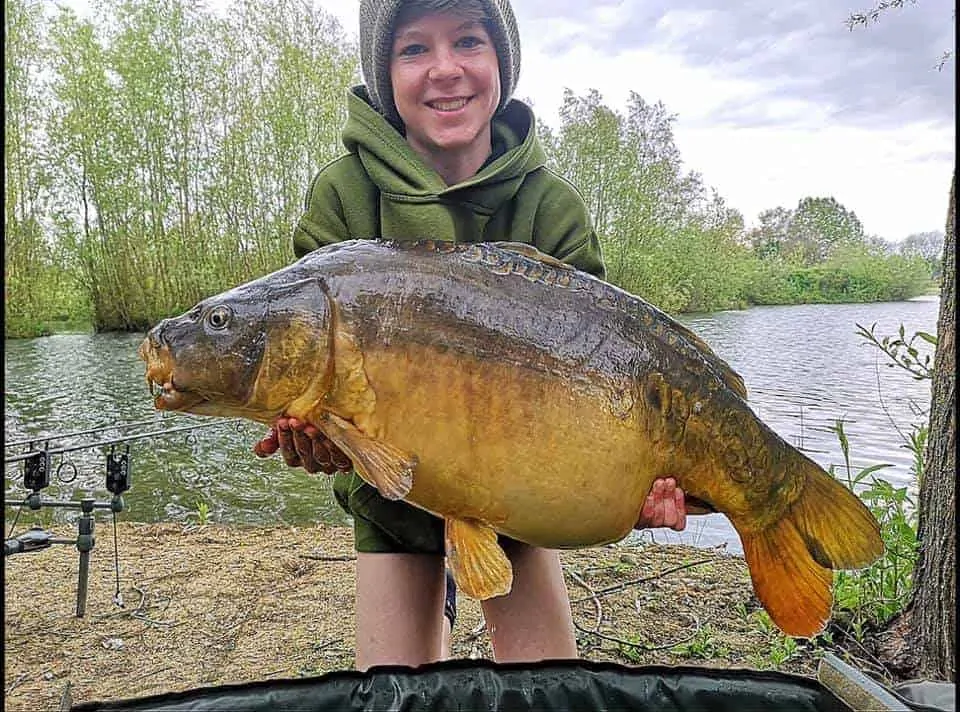
Features and Appearance
The mirror carp is the other core carp type of the Cyprinidae family, together with the common. It is also a direct descendant of the common carp that came to be due to domestication and breeding by European monks.
Over time, they decreased the number of scales on the common carp in their ponds, in order to make it easier for people to prepare the fish in the kitchen. It was this alteration that led to the creation of the mirror.
Mirror carp have scattered patches of scales all over their body. Those patches of scales, or even just individual scales, can greatly vary in size and can be found on different parts of the mirror’s body.
This is why few mirror carp look alike and why anglers have such an easy time recognizing individual fish in a venue.
As mirror carp were mostly bred in still water, such as ponds and smaller lakes, their body shape is, unlike the common carp’s, not adapted to flowing water.
They are mostly very deep and round fish that can pack up a lot of body fat. Despite that fact, they can grow into very beautiful fish that are often brown or dark brown in color and that can give an angler a very good fight.
Average Size
The average size of a mirror carp is very much equal to that of a common. But, thanks to their rounder body shape, mirrors often weigh slightly more than their common relatives, as there is simply more meat and fat on them.
Hence, the average weight for mirrors can be considered to be around 15 to 30lb. A truly huge mirror carp starts at a weight of 50lb.
Record Catches
The British record mirror carp is a fish that weighed in at 71lb 4 oz in The Avenue (RH Fisheries) in 2016.
in 2018, a new mirror world record was caught in the Hungarian carp venue Euro Aqua. This enormous fish weighed 112lb 14oz.
Related Article: Mirror Carp (A Complete Guide With Facts And Pictures)
Recommended Carp Fishing Gear
If you are into carp fishing and want to read up on gear and tackle, make sure to check out our recommended carp gear page as well! It’s packed with valuable tips and advice!
Fully-Scaled Mirror Carp

Features and Appearance
This type of carp is a variation of the mirror carp, which can be covered fully, or almost fully, by its scales. This feature can make it rather easy to confuse the fully scale with a common carp.
The important difference between the two is the pattern and size of the scales. Unlike the common, the full-scaled mirror carp has larger scales that are neither perfectly aligned nor replicated.
Sometimes, fully scales are not entirely covered by their scales either, which is something that would simply not occur on a common carp.
Its overall body shape and coloration are otherwise very close to that of a mirror carp.
Average Size
The average size of a fully scaled mirror carp can be considered somewhat smaller than that of a conventional mirror carp. This type of carp does not appear to grow as much as the mirror either.
Its average size can be put somewhere between 10 and 20lb. A fully scaled mirror above 20lb can without a doubt be called a big fish.
Linear Carp
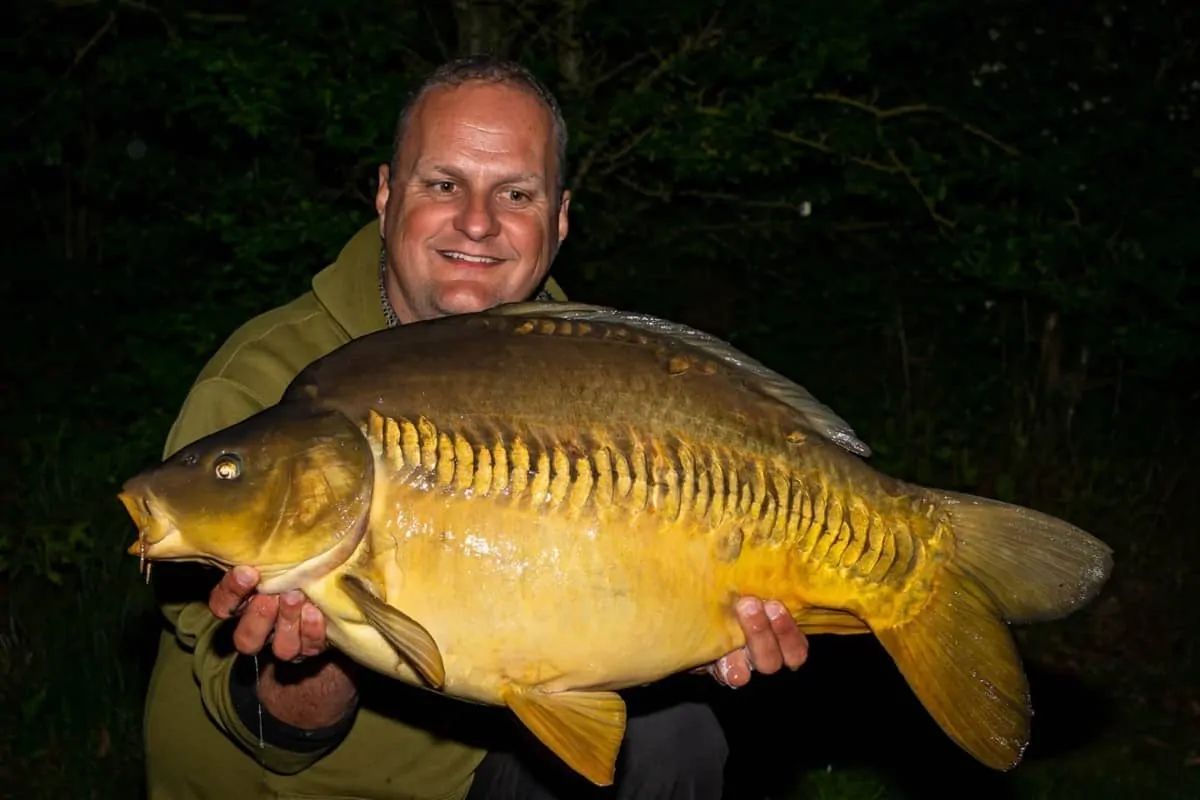
Features and Appearance
The linear carp is not a separate carp type in itself either, but rather another variation of the mirror carp. If you ask me, it can however be considered to be one of the most beautiful types of carp.
The linear carp get its beautiful name from the line of scales along its lateral line, which is usually quite a distinct feature of this carp. This line can often consist of the only scales the carp possesses, but more often than not, it has more scales or patches of them all over its body.
These help to remind one that the linear is just another subcategory of the mirror.
The linear carp is often even referred to as a zip carp, and in the past, it was simply called a line carp.
Its body shape and general colors are also closely related to those of the conventional mirror carp. In fact, when it comes to overall appearance, the linear is probably the most similar to the mirror.
Average Size
The average size of a linear carp can be considered almost similar to that of a mirror carp, which is to say that its average size is between 12 and 25lb.
As they are somewhat less commonly caught, big linear carp can be considered to weigh 30lb and above.
Leather Carp

Features and Appearance
The leather carp (Cyprinus carpio nudus) is genetically somewhat different from both common and mirror carp and the result of altered genome sequencing for food source purposes in various Asian countries, most notably in South Korea, where the leather carp is a major food fish.
Author’s note: From this day forward, the leather carp should bear its Latin name and be called the nude carp! (I found that name highly amusing)
This carp type is very scarcely scaled, and usually only has a couple of large scales close to its tail fin, as well as a line of scales along the dorsal fin.
It is this lack of scales that makes their skin rather leather-like and, hence, gives this carp its name. It is also its most obvious visual feature, which makes it close to impossible to confuse this carp type with any other.
Its body shape is otherwise very close to that of the mirror carp. Its coloration, on the other hand, is usually somewhat darker or greyish.
Average Size
The average size of the leather carp can be considered to be between 10 and 20lb. Leathers above 20lb can be called decently sized carp, while fish above 30lb can definitely be considered to be large specimens.
Record Catches
The British record carp is the legendary “Heather the Leather”, a fish that was more than 50 years old and weighed a good bit over 50lb.
Britain’s most famous fish put on a record weight of 54lb 8oz and was caught back in 2006 in Car Park Lake (Yateley Complex).
In 2010, heather died, presumably of old age, and was discovered dead at the edge of her lake. Local carp anglers gave her a proper burial and marked her grave with a headstone and a memorial rose bush.
Ghost Carp
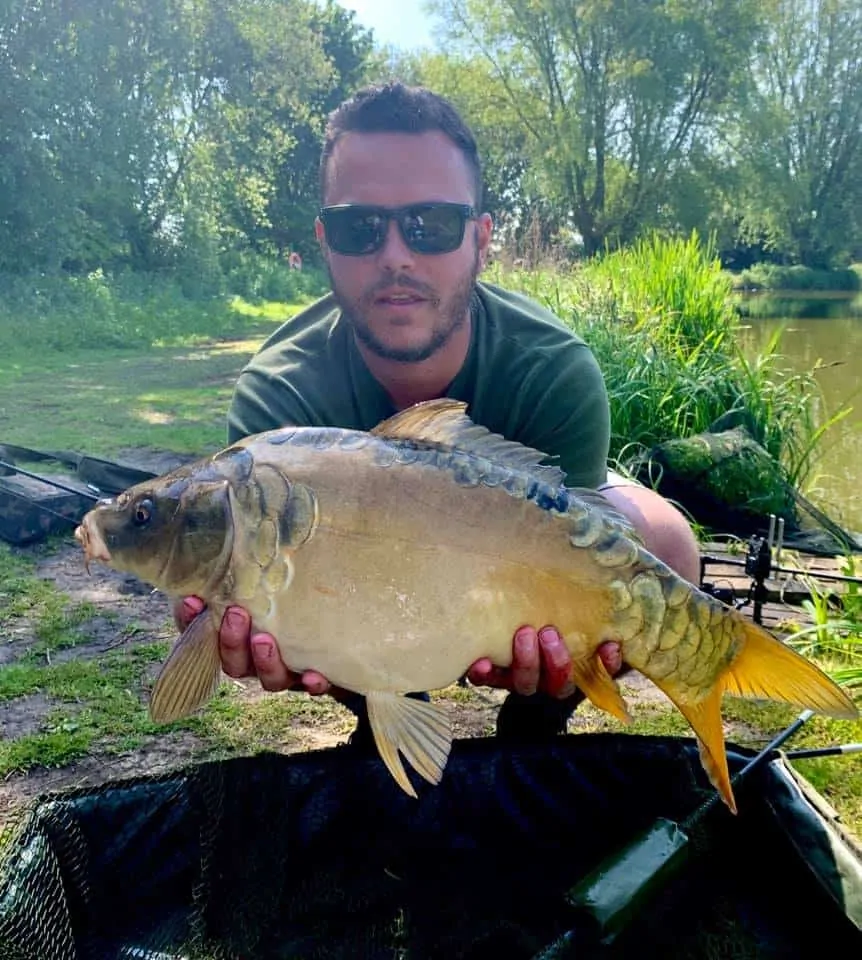
Features and Appearance
The ghost carp is a hybrid between a common (or mirror) carp and a koi carp. Most commonly, conventional carp are cross-bred with Ogon koi.
These koi are commonly whitish, metallic, or greyish in color, which explains the color variations of the ghost carp.
It is these colors that also explain the name “ghost carp”, along with its other, very distinctive feature; the metallic and dark markings on its head and body.
Very often, ghost carp will have a dark or black mark, or ring, around their eyes, giving them a rather eerie and ghostly look underwater.
Their body color is also usually somewhat washed out or faded, which makes it easy to tell them apart from true koi carp and their stronger and brighter colors.
As they are the result of both common and mirror-koi breeding, there are hence also both mirror and common looking ghost carp in many venues around Great Britain.
Average Size
The average size of a ghost carp compares to those of common and mirror carp and can be set around 10-20lb. Due to their genetic closeness to the common and mirror, they vastly outgrow the much smaller koi carp.
Record Catches
The British record is a whopping fish of 65lb 14oz (venue unknown). In Europe, there is an unofficial ghost carp record of 94lb (venue unknown), which nonetheless does not sound all that impossible.
Grass Carp
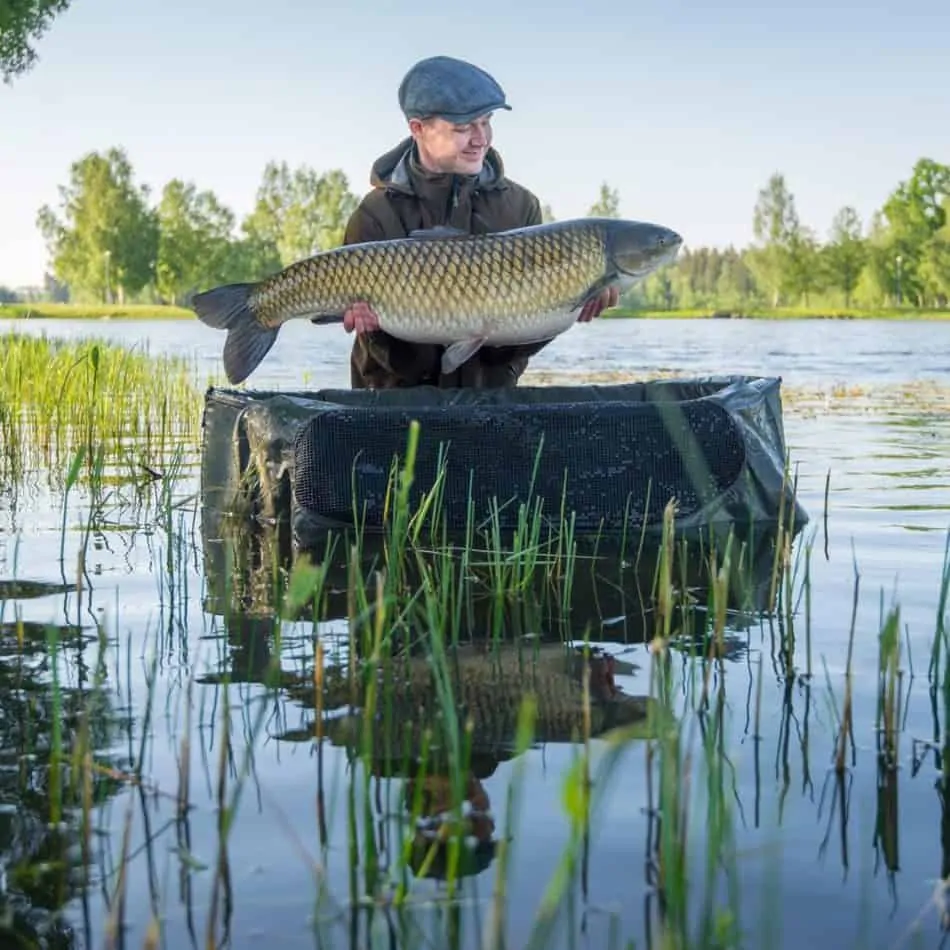
We are now leaving the closely related carp types behind and moving on to somewhat more distant varieties of carp. Let’s start with the biggest of them; the grass carp.
Features and Appearance
The grass carp (Ctenopharyngodon idella) is a separate carp type that is only a distant relative of the common carp, while still belonging to the Cyprinidae family.
While being cultivated in Asia for food purposes, it was introduced in many European and North American waters for weed control. This fish loves to eat all types of aquatic plants, which explains its somewhat odd name.
This carp type can grow to an enormous size and holds unbelievable power reserves, which it though usually first unleashes near the landing net. This sudden explosiveness is a very distinctive feature of the grass carp.
While its torpedo-shaped body and scale pattern remind of that of the common carp, it actually looks much more like a giant chub than a typical carp. It also lacks the so carp-typical barbels near its mouth.
Average Size
This carp’s average size can be considered to be between 15 and 30lb. Fish above 40lb deserve to be called really big grass carp, while fish that weigh more than 60lb are true monster grassies!
While being somewhat smaller in the UK, the grass carp is a real giant in other European countries, as well as in the United States.
Record Catches
The British record is a fish of 53lb 12 oz, caught in Little Moulsham Lake (Yateley) in 2018.
The world record is a gigantic grass carp of an unbelievable 87lb 10oz, which was caught in the Piasuchnik Dam in Bulgaria back in 2009.
PRO TIP: Check out the quick visual article summary in the related Google Web Story here!
Koi Carp

Features and Appearance
Koi is simply an informal group name of the colored variants of the common carp. The word koi is Japanese and means “brocaded carp”. They were originally bred in Japan since the 1820s and are mostly kept as decorative fish in ponds or water gardens.
The hobby of keeping koi carp as decorative pets eventually spread all over the world and one by one, the koi found their way into a large number of fishing venues.
This carp type comes in over 100 different variants and all the colors of the rainbow, which makes it an extremely fun and exotic fish to catch.
As it is so closely related to the common carp, there exist both mirror koi and common koi. The ghost koi combination is another frequently caught type of koi, especially in the UK.
The koi shares all the major features of the conventional carp, including the common carp’s barbels and strength.
Average Size
Koi carp are usually smaller than common carp and do not grow to the same record sizes either. At least not in lakes, that is, as there have been recorded pond koi carp of over 90lb!
Its average size can be set somewhere between 10 and 20lb, while koi carp above 25lb can be considered rather large specimens.
Record Catches
There is not much data on rod-caught record koi carp, but the British record for the ghost koi was a fish of 47lb 14oz. This koi was caught in one of the Nunnery lakes (Thetford) in 2017.
Crucian Carp
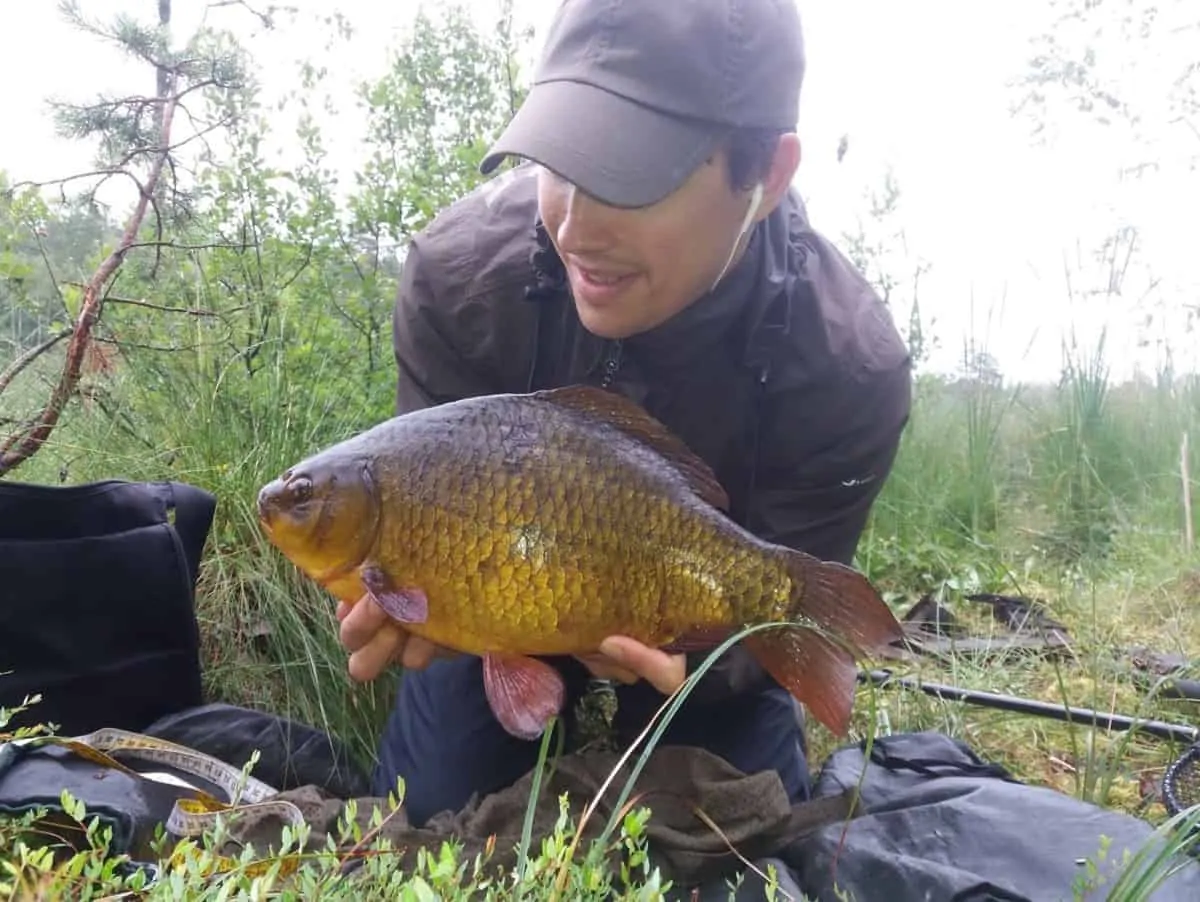
Features and Appearance
The crucian carp (Carassius carassius) is one of the smallest members of the carp family and is native all over Europe. It is a fish that can be extremely hard to catch, as it is said to be a very cautious feeder. I fish a lot for crucians myself and can definitely second that!
Although small, the crucian carp’s scale pattern reminds a lot of that of the common carp. Crucians do however not have any barbels, unlike the conventional carp.
It is a rather mysterious fish that only reveals itself through its numerous feeding bubbles, if and when it is feeding in an angler’s swim. It also has a very small mouth opening, making it even harder to hook and land.
One very peculiar feature of the crucian carp is that it can survive in both extreme temperatures and in very poorly oxygenated water.
You can find crucians in lakes where few or no other fish can survive in, and during very harsh winters, they can dig themselves into the lake sediment and have their bodies produce ethanol, in order to keep up their body temperature and remain breathing.
That is something no other carp type can do!
Crucian carp are usually golden-brown or dark-brown in color and either have a sleeker body shape (in waters without a lot of predators), or a much deeper one (in bodies with a lot of predators).
This is yet another of the crucian’s remarkable ability to adapt to its environment.
Average Size
In the UK, they appear to be somewhat smaller than in the rest of Europe and weigh on average around 2lb. In other European countries, their average weight is somewhat higher; around 2 to 4lb.
Record Catches
The UK record is a crucian carp of 4lb 10oz, caught in Johnsons Lake (Milford) in 2015.
The world record is an amazing crucian of 9lb 8oz. It was caught in a lake in the Netherlands in 2009.
If you want to find out more about the mysterious crucian carp, you should also read this article I wrote: Crucian Carp (Facts And Mysteries About Them)
Silver Carp
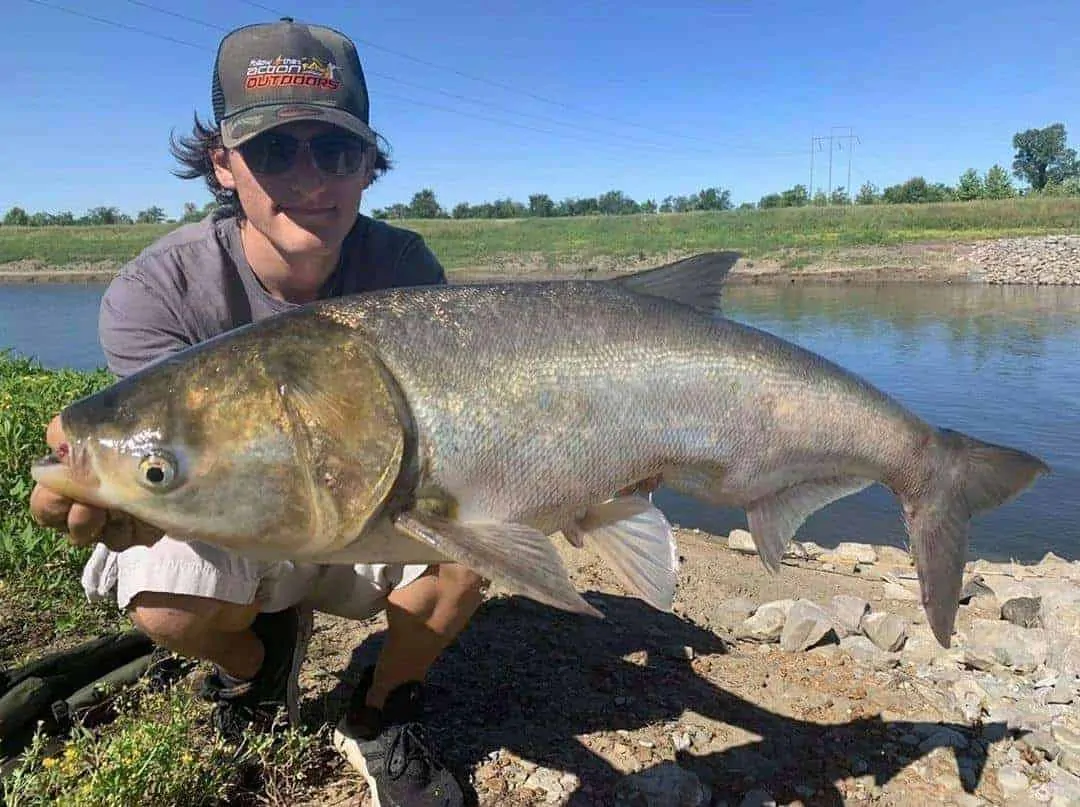
Features and Appearance
The silver carp (Hypophthalmichthys molitrix), which also goes under the name Asian carp, is another distant relative of the common carp, and a rather large one at that.
This carp type is predominantly found in Asian countries but has even made its way to Europe and North America. Wherever it was introduced, it was meant primarily for aquacultural purposes or the enhancement of wild fisheries.
The silver carp, as its name suggests, has a strong silver coloration and a disproportionately large head, which are its two most obvious features.
Another two very distinct features are its eyes, which sit very low on its head, as well as an extremely large, upturned mouth.
Average Size
Sizes of this fish vary a lot from country to country, but in the States, as well as in Europe, its average size is somewhere between 20 and 40lb. Very large silver carp have been reported to weigh over 100lb.
Record Catches
The official world record silver carp is a giant of 51 inches and 106lb 15oz. This monster was caught in the Erlensee (Germany) in 2004.
If you want to read up on common carp vs buffalo fish, two species that people in the U.S. easily confuse, check out this article as well: What Is The Difference Between Buffalo Fish and Carp?
Bonus: F1 Carp

Features and Appearance
This last carp type is a rather interesting hybrid, which was intentionally bred for commercial fisheries in the UK. The F1 carp is a mixture of common and crucian carp.
It has gained a lot of popularity among match English match anglers, as it does not grow very much, while at the same time being a very strong fish.
As a result, many fisheries all over Great Britain have introduced the F1 carp in their venues.
Visually, it both clearly resembles a common and a crucian. On the color side, it has more of the common carp’s gold and golden-brown in it. On the crucian side, it shares the feature of not having any barbels.
Average Size
The F1 carp does not grow very big, and hence, its average weight is somewhere between 2 and 4lb.
Record Catches
The British record for the F1 carp is currently at 7lb 14oz and was caught in the Boundary Pool (Manor Farm Leisure) in 2016.
Essential Tackle Tips
If you’re looking for solid and reliable carp fishing equipment, these tips might be useful for you.
The following tackle is of top quality and sells at a very decent price on Amazon.
I have been using this setup myself for many years and have caught plenty of big carp with it.
Rod: Daiwa Black Widow
A very strong and beautifully made 12ft 3lb carp rod with a ton of backbone and a great bend. Casts anything up to 5 oz extremely well and lets you navigate and control your fish smoothly and effectively. Fits both open and snaggy waters.
Reel: Shimano Baitrunner DL 6000
A reliable standard-sized baitrunner reel that works great for short to medium-distance carp fishing. Loads around 200 yards of 15-18lb monofilament mainline. Handles any wild run very smoothly! Fits the Black Widow rod perfectly.
Mainline: Daiwa Sensor 15lb
One of the strongest and most durable monofilament lines out there! Sells at a very good price and will last you for many fishing trips. Has just the right amount of stretch to perfectly hook and fight every fish.
Featured image courtesy of Ian and Scott Strotten


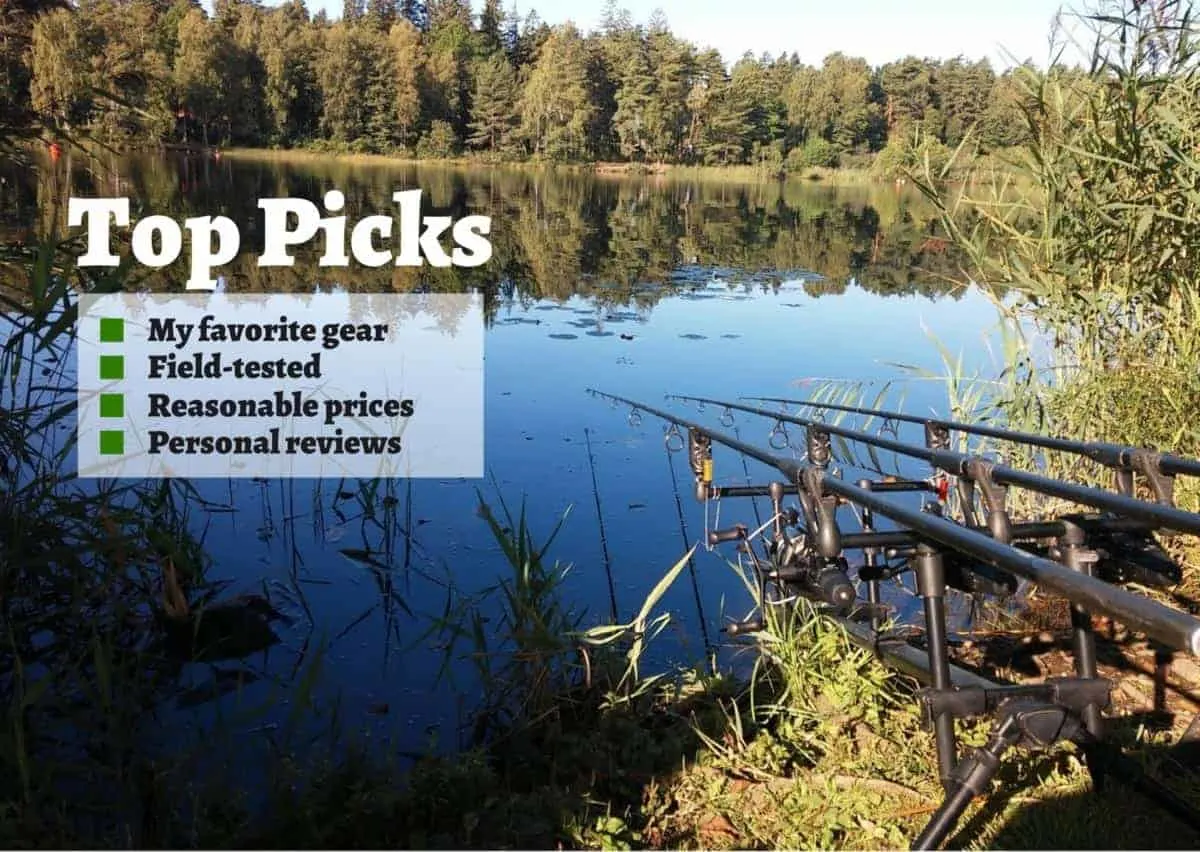
I was bowfishing and caught a Koi Carp I weighed at 26 lbs, this was in 2020.
To me, that’s certainly an odd way of targeting carp. 🙂 Are you fishing for them with line and hook as well? All the best /Max